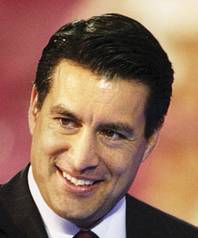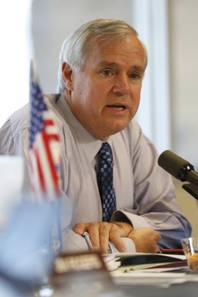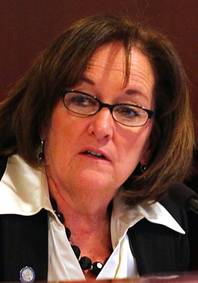
Education officials only see doom in meeting the strict budget cut demands of Gov. Brian Sandoval’s administration is to take drastic measures: Close schools, lay off teachers, and many other “sky is falling” claims. But the Nevada Board of Regents finally said “Let’s calm down and be rational and we’ll work this out.”
Wednesday, March 16, 2011 | 2 a.m.

Brian Sandoval

Chancellor Dan Klaich

Debbie Smith
Sun archives
- UNLV president presents cuts, says they are “a tragic loss and a giant step backward for Nevada” (3-8-2011)
- UNLV president’s somber warning on budget cuts moves faculty to tears (2-16-2011)
- Regent says it’s time that K-12 shares in budget sacrifice (2-8-2011)
- Higher education officials say Sandoval budget cuts a ‘death sentence’ (2-4-2011)
- Education in forefront of upcoming budget battle (1-30-2011)
- Chancellor: University tuition would have to go up 73 percent to cover Sandoval budget gap (1-27-2011)
- School officials warn of jobs cuts, larger classes under proposed budget (1-26-2011)
- A steep climb for Nevadans (1-26-2011)
- Soft words during State of the State hide Nevada in pain (1-25-2011)
- Teachers not pleased with most of Sandoval’s speech (1-25-2011)
Higher education is trying a new approach to proposed budget cuts: honesty.
After three years of reacting to proposed budget cuts with vague prophecies of doom — thousands of layoffs, eliminating athletic teams and the closure of popular schools — the higher education system is trying to provide detailed and more realistic scenarios for what would happen under Gov. Brian Sandoval’s budget.
But in their effort to be forthright, some higher education officials worry they are hurting themselves politically by making cuts appear less dire.
On Friday, a divided board of regents voted to keep open all eight institutions of higher education, including Nevada State College, Desert Research Institute and the three Northern Nevada community colleges.
Chancellor Dan Klaich had issued a memo last month, asking that the system assess closing some campuses, although he was careful not to endorse the idea. Despite that, students from Desert Research Institute and community colleges filled the regents meeting, fearful of such possibilities.
After the vote, Klaich warned that the budget cuts would still be painful. The institutions’ presidents noted the possibility of layoffs and the elimination of programs.
But the nuance was lost on many in the audience.
“We’re safe, we’re safe,” exclaimed one Western Nevada College student, according to Carson City’s Nevada Appeal.
That’s the downside of taking the most dramatic cuts off the table: The sigh of relief from students meant there was less pressure on legislators and Sandoval to find more money to preserve the system.
“I think it’s very unfortunate the board may have unintentionally sent the message that things are not nearly as dire as they very well could be,” said James Dean Leavitt, chairman of the regents. He and four others voted against the motion.
Whether it’s higher education, Nevada K-12 schools or health and human services, campaigning against budget cuts is an exercise in mobilizing supporters to clamor for services and pressure policymakers.
Conservatives claim that those in favor of tax increases use the most visible cuts as a scare tactic to score political points — dramatic testimony from the person in the wheelchair, closure of the popular park because it’s a favorite of children.
Nevada’s higher education system has been accused of such hyperbole or obfuscation in recent years.
In December 2007, when former Gov. Jim Gibbons asked state agencies to prepare 8 percent cuts, then-Chancellor Jim Rogers warned it would cause “permanent and irreparable damage.” In May 2008, he compared proposed cuts with amputating limbs.
(The same analogies have been used to describe the effect of Sandoval’s cuts.)
In 2009, even the Democratic lawmakers who would eventually support a tax increase became frustrated with higher education.
“I feel like we’re just doing a dance here. We’re talking in general terms,” said Assemblywoman Debbie Smith, D-Sparks, at a March 2009 budget hearing. “We have to figure out what happens in this budget. And I don’t feel like the answers are forthcoming.”
On Tuesday, Smith, chairwoman of Ways and Means, said, “I think we’ve had more openness with the chancellor.”
She said she has been clear with K-12, higher education and other advocates: “The public should know what the possibilities are, but they have to be what’s truly going to happen. I don’t think outrage needs to be manufactured.”
Regent Ron Knecht, a conservative from Carson City who made the motion to take the campus consolidations off the table, said closing institutions was among “the least likely alternatives.”
He said he’s heard concern that his motion would hurt the system’s chances of getting more money.
“If taking the worst contingencies (off the table) eases the pressure on the governor and Legislature to close the budget gap, it’s worth it because of the human cost of the uncertainty,” he said. “We’ve tried to shed the reputation of hyperbole.”
Sandoval’s staff applauded the move, and said the plan was “realistic.”
“None of these decisions are easy, but they’re realistic,” said Dale Erquiaga, Sandoval’s senior adviser.
The cuts proposed by system presidents include:
• At UNLV, ending 33 degree programs and eliminating 315 jobs. This includes closing the philosophy and social work departments.
• At UNR, eliminating degree programs, departments and 215 jobs.
• Truckee Meadows Community College would target high-cost programs such as nursing, radiology, dental hygiene and first responders.
• The College of Southern Nevada plans to cut 28 percent of its class sections, enough to reduce student capacity by 3,800.
Regents said they were looking at raising tuition by 10 to 15 percent.
This session, Erquiaga complained the higher education system was not correcting the often-repeated claim that Sandoval’s budget would mean a 73 percent increase in student tuition. Although technically accurate — that’s the amount of additional tuition needed to cover the $162.4 million cut — it was never a realistic proposal, Erquiaga said in February.
Klaich said he has stressed that these cuts are not exaggerations. “I have absolutely been clear from Day One that I will do everything in my power to give true facts and information.” The effects of the cuts, he said, “are bad for Nevada. They will keep us mired in the recession, retard economic development and recovery this state needs.”
Rogers, owner of television stations (which are news partners with the Las Vegas Sun), denied his past statements were exaggerations. The system has suffered because of the budget cuts.
“The schools are still there, but they’re a shadow of what they could have been if funded properly,” he said. Each cut caused greater and greater harm, he said.
If he has used explosive language it was “to make a point of it,” he said. “Unless you hit them in the head with a brick, people won’t listen.”

Join the Discussion:
Check this out for a full explanation of our conversion to the LiveFyre commenting system and instructions on how to sign up for an account.
Full comments policy